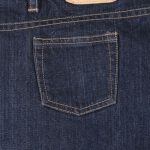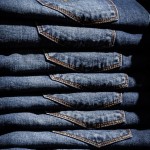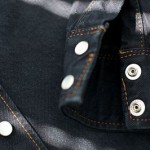
by MakeYourOwnJeans | denims, jeans |
When researching the different types of denim, you may come across a term called “selvage.” It’s certainly not as popular as dry or raw denim, but many companies still use selvage denim in their products. Selvage denim is a type of cotton twill fabric — just like raw or dry denim — that’s woven together to create a stronger, more durable textile. What makes it unique, however, is the way in which it woven. Selvage denim is created through the use of a single continuous cross-yard called the weft. The person or people creating selvage denim weave the weft back and forth through the warp upright warp beams, never cutting or breaking the single weft. In most cases, the edges feature a contrasting warp, such as red, allowing the creator to see exactly where the weft begins and where it ends. While there are several different methods for creating selvage denim, many people prefer to use shuttle looms. This otherwise simple tool weaves a narrow 30-inch fabric back and forth; thus, creating the unique pattern of selvage denim. Because the shuttle loom uses fabric that’s roughly half the size of a shutlleless loom, longer pieces of fabric are required (roughly three yards at minimum. In an effort to produce more denim and eliminate waste, companies often create jeans using wide denim that have a straight outseam. This allows them to utilize the full width of the fabric, including the edges. Selvage denim is frequently used in the production of premium, high-end jeans, as it shows the finished edges in a contrasting color as opposed to the overlocked edges on traditional...
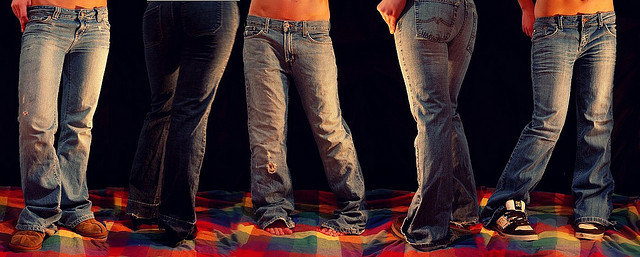
by MakeYourOwnJeans | denims, jeans |
It’s no secret that the majority of jeans produced today are made of denim. Whether they are straight-leg, slim-fit, low-rise, boot-cut, etc., chances are they are made of denim. This has become the defacto material of choice among companies that produce jeans. But what exactly is denim? And why do so many companies prefer it? These are just a few of the many questions that we’re going to answer today. Denim is essentially a type of cotton twill textile that’s characterized by the passing of the wefts. In order for denim to be created, the weft of cotton twill must pass under two or more warp threats; thus, creating a woven fabric with two diagonal crossing patterns. So in other words, denim is nothing more than cotton that’s been wrapped and woven to in a specific manner. As long as the wefts are passed in a honeycomb pattern, it can essentially be called denim. If you look closely at a pair of indigo (dark blue) colored jeans, you’ll notice the inside is actually white. This is somewhat confusing since the outside maintains its distinct indigo color. This color variation is due to the fact that the core of the warp threads remain white throughout the dyeing process. So even though the exterior of the twill threads are indigo, the insides are white. It’s believed that most dry denim is sources from the USA, Zimbabwe and Japan, although there are several other countries known to grow cotton and produce denim. The USA, however, remains the world’s leading supplier of denim, thanks largely in part to its climate and landscape that’s...

by MakeYourOwnJeans | denims, Fashion, jeans |
In the market for a new pair of jeans? Finding the “perfect” pair of jeans can be grueling, daunting task. You may spend an entire day shopping at various department stores all to no avail. And even if you happen to a find a pair you like, they may not be the right size. To make this task a little easier, we’ve compiled a list of things to consider when shopping for a pair of jeans. Color When shopping for a new pair of jeans, pay close attention to the color. The most commonly worn colors are light blue and indigo. However, you’ll find jeans are available in a wide range of different colors, some of which include red, yellow, black, green, and pretty much every other color under the rainbow. Opting for one of these colorful varieties is a fun way to express yourself while stepping away from the normal trend. With that said, be conscious of the color of jeans and how it affects the rest of your outfit. Fabric Similar to cotton corduroy, denim is the single most commonly used fabric in the production of jeans. It’s soft, durable, long-lasting and inexpensive, making it the ideal choice for jeans. However, jeans are also available in a cheap, coarse type of thick cotton cloth, known as dungaree. Dungaree jeans were popular back in the 1700-1800s in India, but they’ve since been replaced with denim. You can still find dungaree jeans available for sale, although most companies have switched over to denim. Cut You can read more about the different jean cuts by checking out some of our...
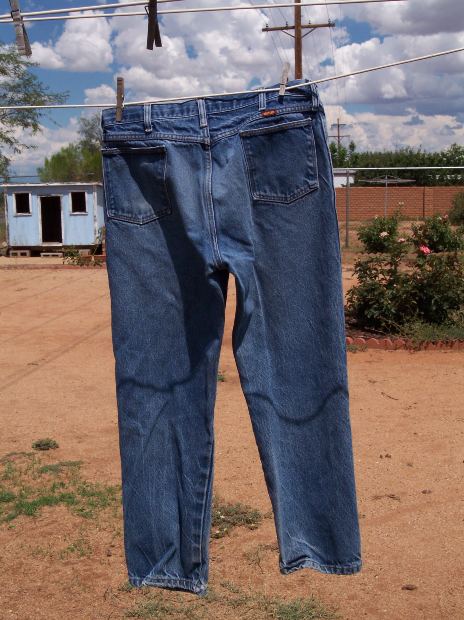
by MakeYourOwnJeans | jeans |
No, the title is this blog post is not a typo. You really can make a pair of denim jeans softer by using salt. All it takes some traditional table salt, water and a little bit of free time. If you’re interesting in creating softer denim jeans, keep reading for a step-by-step walkthrough on this process. First and foremost, it’s important to note that most jeans will naturally become softer as you wear and wash them. This isn’t something that happens overnight, but after wearing and washing the same pair of denim jeans for months on end, they will eventually feel softer than before. This is due to the fact that machine washing wears down the denim fibers, making the smaller, smoother and less rough. You can speed up this process, however, through the use of good old fashioned salt. To make your jeans softer using salt, fill a large bucket with one gallon of lukewarm water and one cup of table salt. Stir the salt around so it’s evenly distributed throughout the water and not settling at the bottom of the bucket. After stirring the saltwater solution, place your denim jeans inside, pushing them to the bottom so they are completely submerged underwater. Now comes the waiting game. Depending on the current state of your jeans, and just how soft you want them, you’ll need to let them soak in the saltwater solution for two to four hours. The longer they soak, the softer they will become. So, go watch a movie, run errands, or do something else to pass the time while your jeans are soaking up...

by MakeYourOwnJeans | denims, jeans |
Jeans come in wide variety of different styles, ranging from slim fit and “skinny” to loose, low-rise and more. Although they may seem similar from afar, each of these styles has its own unique characteristics. While most people are familiar with the styles previously mentioned, one style that’s often confusing is stone wash. In this post we’re going to take a closer look at stone wash denim, revealing how it’s created why it remains such a popular choice among men and women. Stone Washing Defined The term “stone washing” refers to the manufacturing process of making denim (or other fabrics) softer and more flexible. As the name suggests, it involves the use of real stones to roughen up the fabric during the production and post-production stages. The stones are used to beat the fabric, making it softer and more comfortable. Denim companies may have their own stone washing techniques, but nearly all of them involve the use of stones. The obvious benefit of wearing stone washed jeans is the simple fact that they are softer and more comfortable. After the stones have beat the denim, it becomes softer and less rough. History of Stone Washing Surprisingly, no one knows when stone washing was invented. The multinational denim company Levi Strauss claims that Donald Freeland, a worker at the Great Western Garment Company, invented the technique back in the 1950s. However, other historians credit Claude Blankiet for inventing stone washing. Regardless of who invented it, it’s safe to say that stone washing is here to stay. In addition to their soft texture, stone washed jeans also exhibit a faded color...
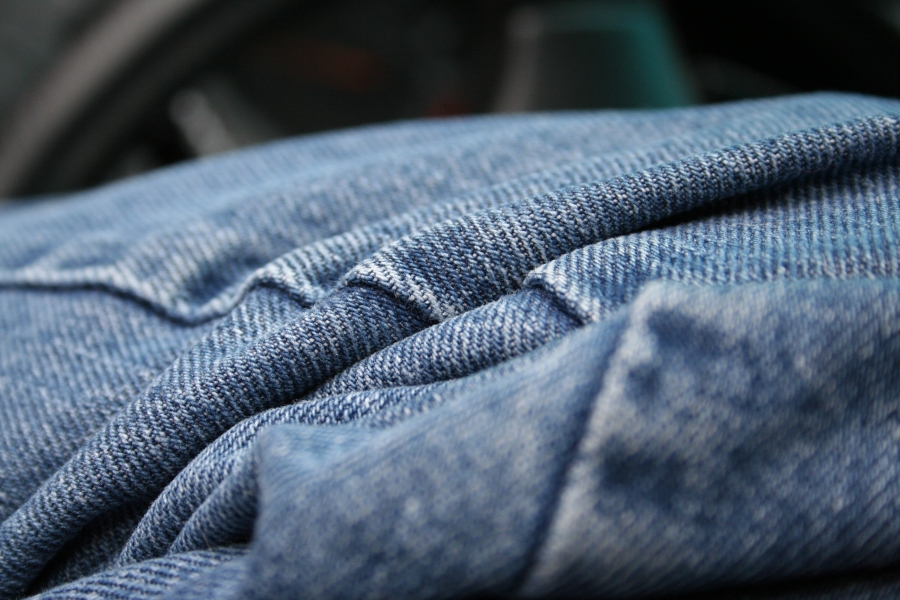
by MakeYourOwnJeans | denims, jeans |
When properly cared for, a good pair of denim jeans can last for years. Over time, though, it’s not uncommon for denim to fade and lose its natural “luster.” Even if they were originally a dark indigo blue when you first purchased them, they may now have more a faded, light-blue tone. The good news is that you can often dye your jeans to revitalize their color and vigor. All it takes is a few basic supplies and a little bit of your spare time. Before we start, it’s important to note that your jeans will be one solid color after they are dyed. If they currently have patches where the fabric is lighter and more faded than other areas, these will be eliminated once they are dyed. Dying creates a uniform color that affected the entirety of the jeans. With that said, the stitching should remain white (or whatever color it currently is), as most denim manufacturers use polyester for the stitching instead of cotton. To get started, you’ll first need to purchase a few things. This includes 1 pack of navy blue or indigo-colored dye, 1 pack of black-colored dye, a pair of latex gloves (trust me, you don’t want to get dye on your hands), and a large bucket. When you are ready to proceed, place the gloves on your hands and fill the bucket about 3/4 of the way full with hot water. Don’t make the mistake of using cold water, as it won’t penetrate as easily through the denim fabrics. Hot water, on the other hand, allows the dye to settle into the denim,...








